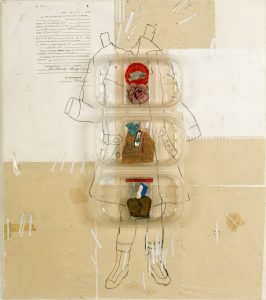Plastica d’artista – Artist’s Plastic (Valeria Vaccari, 2003)

The essence of Monika Wolf’s work is the effect produced by the passing of time on material things. The original material is transformed and reassembled according to the artist’s unerring eye, which captures the tones of rust, the grain of wood, or colour washed by rain. In this way Monika Wolf creates portable microcosms, the heart of those things that every human being has within. And these microcosms become the internal “organs” of the work exhibited for Plastica d’artista. The work links the idea of clothing, a theme in the artist’s earlier paintings, to the idea of a container of “essence” portrayed by the assemblages. Clothing is a screen, both revealing and covering the body, and expressing the individual’s personality but concealing their soul. In ancient times the soul was thought to reside in the heart or in mysterious glands whose functions were not known. The assemblages placed on the dress resemble these organs, the hidden and original part which becomes worn and rusty with time but which makes each individual unique.
The alchemical element, found in all the artist’s work, appears again here. Even the canvas on which the dress is drawn is marked by the passage of time, and must be patched, mended and held together by paper. The artist stimulates the viewer to physical contact with the work, providing scope for free play of the imagination. The dress portrayed resembles those used for dressing cardboard cut-out dolls in the past, and some memory of childhood can be found in all Monika’s work, either in photo form or oniric representation. The plastic, in standard container form, surrounds the artistic nucleus and, being neutral, does not interfere with it. Its transparency contrasts deliberately with the work and the spectator is invited to give the plastic tray a wider meaning, according to occasion.
Valeria Vaccari, text for “Nascita Registrata N. 1432”, exhibited in “Plastica d’Artista” in the Museo Nazionale della Scienza e della Tecnologia “Leonardo da Vinci”, Milano).